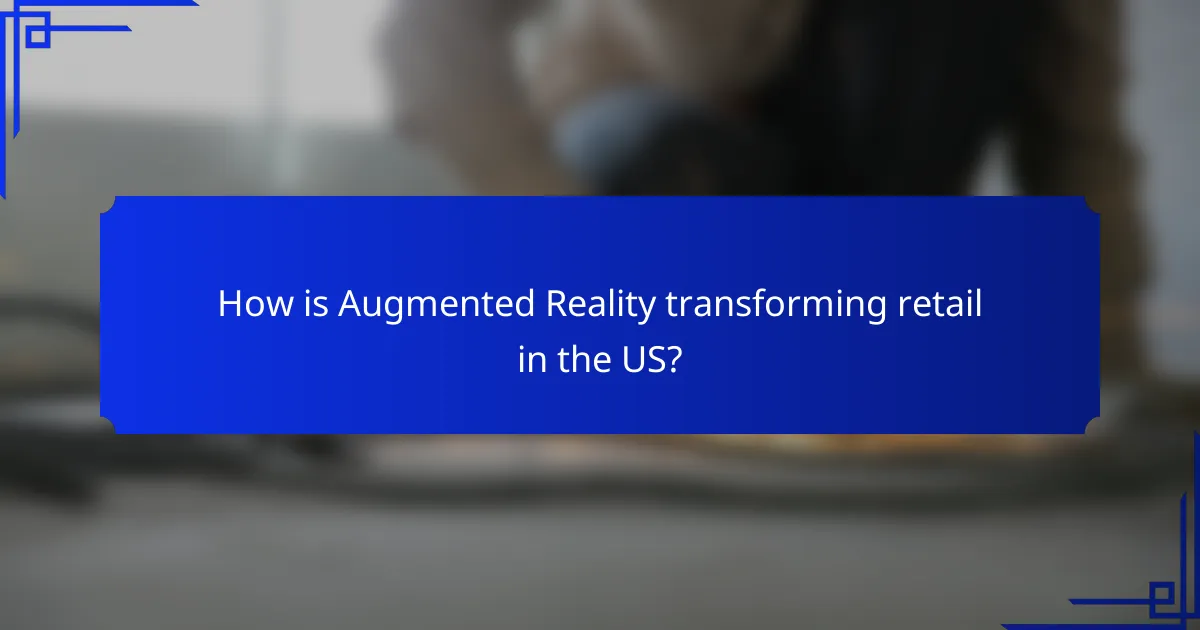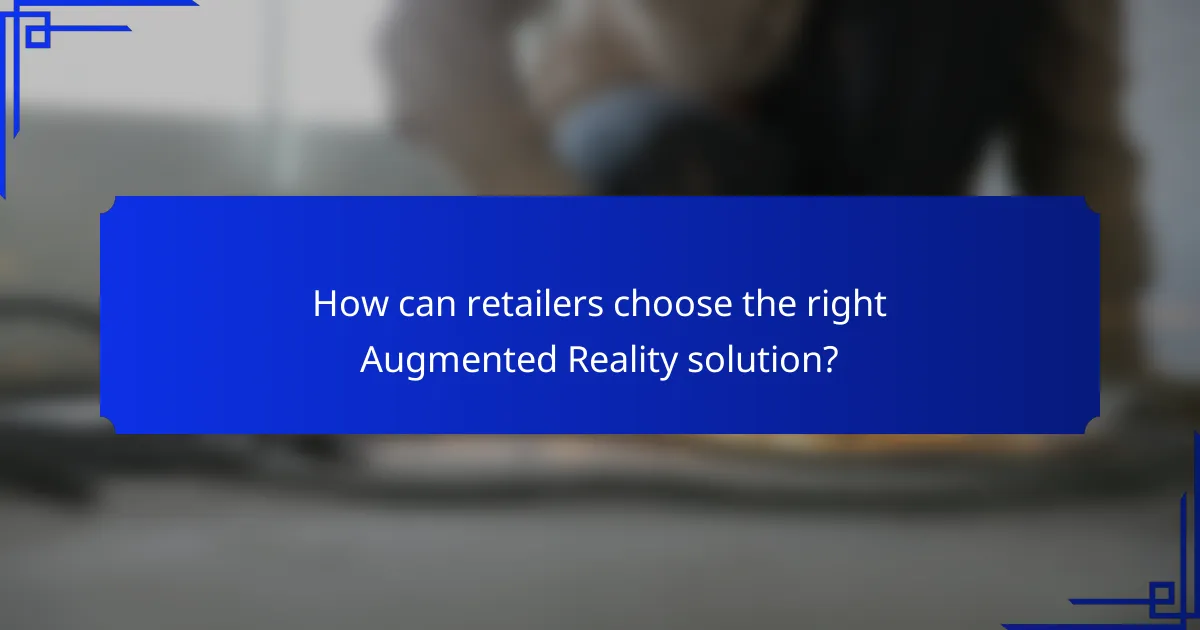Augmented Reality (AR) is revolutionizing the retail landscape by providing customers with interactive and immersive shopping experiences. Retailers are increasingly adopting AR technology to engage consumers, enhance personalization, and streamline operations, ultimately leading to higher sales and lower return rates.

How is Augmented Reality transforming retail in the US?
Augmented Reality (AR) is significantly transforming retail in the US by enhancing the shopping experience through interactive and immersive technology. Retailers are leveraging AR to engage customers, boost sales, and provide personalized experiences that meet modern consumer expectations.
Enhanced customer engagement
AR fosters enhanced customer engagement by allowing shoppers to interact with products in a virtual space. For instance, customers can use their smartphones to visualize how furniture would look in their homes before making a purchase. This interactive experience not only captures attention but also encourages longer browsing times.
Retailers can implement AR features such as virtual try-ons for clothing and accessories, which can lead to increased customer satisfaction and loyalty. Engaging customers through AR can also create buzz on social media, further amplifying brand visibility.
Increased sales conversion rates
Implementing AR in retail can lead to increased sales conversion rates by providing customers with more confidence in their purchasing decisions. Studies suggest that customers who use AR features are more likely to complete a purchase compared to those who do not. This is particularly true for high-involvement products where visualizing the item can alleviate hesitation.
Retailers should focus on integrating AR into their e-commerce platforms and physical stores to maximize conversion opportunities. Simple AR applications, like showing how a product fits or looks in real life, can significantly influence buying behavior.
Improved product visualization
AR enhances product visualization by allowing customers to see items in a real-world context. This technology enables shoppers to examine products from different angles and understand their dimensions and features better. For example, cosmetics brands often use AR to let customers see how makeup products will appear on their skin.
By providing a clearer picture of the product, AR helps reduce return rates, as customers are less likely to be disappointed with their purchases. Retailers should ensure that their AR applications are user-friendly and provide high-quality visuals to maximize this benefit.
Personalized shopping experiences
AR can create personalized shopping experiences by tailoring content and recommendations based on individual customer preferences. For instance, AR apps can analyze a user’s past purchases and suggest complementary items, enhancing the overall shopping journey.
Retailers can further personalize experiences by incorporating user data to adjust AR features, such as virtual fitting rooms that suggest sizes or styles based on previous selections. This level of personalization not only improves customer satisfaction but also encourages repeat business.

What are the key benefits of Augmented Reality in retail?
Augmented Reality (AR) in retail offers several key benefits, including enhanced customer experiences, lower return rates, and improved inventory management. By integrating AR technology, retailers can create interactive shopping environments that engage customers and streamline operations.
Boosted customer satisfaction
AR significantly boosts customer satisfaction by providing immersive shopping experiences. Customers can visualize products in their own space before making a purchase, which helps them make informed decisions. For example, furniture retailers often use AR apps to allow customers to see how a sofa would look in their living room.
Additionally, AR can personalize the shopping experience by offering tailored recommendations based on user preferences. This level of engagement often leads to increased loyalty and repeat purchases.
Reduced product returns
One of the major advantages of AR in retail is its ability to reduce product returns. By allowing customers to virtually try on clothes or visualize products in their home, AR helps ensure that the items they choose meet their expectations. This can lead to a significant decrease in return rates, which can often be as high as 30% in online retail.
Retailers can further enhance this benefit by providing clear AR visuals that accurately represent the size, color, and fit of products. This transparency helps customers feel more confident in their purchases, ultimately leading to fewer returns.
Streamlined inventory management
AR technology can streamline inventory management by providing real-time data visualization and tracking. Retailers can use AR to monitor stock levels and product placements more efficiently, reducing the time spent on manual inventory checks. This can lead to improved accuracy in stock management and better decision-making regarding restocking.
Moreover, AR can assist in training staff on inventory processes, helping them understand product locations and stock levels quickly. This enhances overall operational efficiency and can lead to cost savings for retailers.

Which companies are leading in Augmented Reality retail solutions?
Several companies are at the forefront of augmented reality (AR) retail solutions, enhancing customer experiences and streamlining shopping processes. Notable leaders include IKEA, Sephora, and Walmart, each offering unique AR applications that cater to different aspects of retail.
IKEA Place app
The IKEA Place app allows users to visualize how furniture will look in their homes before making a purchase. By using AR technology, customers can place true-to-scale 3D models of IKEA products in their own space through their mobile devices.
This app not only helps in decision-making but also reduces the likelihood of returns. Users can easily share their designs with friends or family for feedback, making the shopping experience more interactive and collaborative.
Sephora Virtual Artist
Sephora’s Virtual Artist app enables customers to try on makeup virtually using AR. Users can see how different products look on their faces in real-time, allowing for a personalized shopping experience without the need for physical samples.
This tool enhances customer engagement and satisfaction, as it helps users find the right shades and products that suit their preferences. Additionally, the app often includes tutorials and product recommendations, further enriching the shopping journey.
Walmart’s AR shopping
Walmart has integrated AR into its shopping experience through various applications, including in-store navigation and product information. Customers can use the Walmart app to scan items and receive detailed information, promotions, and availability in real-time.
This AR feature not only improves the shopping experience but also helps customers save time by guiding them to the products they need. Walmart’s approach emphasizes convenience and efficiency, catering to the modern shopper’s expectations.

What are the challenges of implementing Augmented Reality in retail?
Implementing augmented reality (AR) in retail presents several challenges that can hinder its effectiveness and adoption. Key issues include high development costs, barriers to technology adoption, and the need for seamless integration with existing systems.
High development costs
The costs associated with developing AR applications can be substantial, often requiring significant investment in technology, talent, and resources. Businesses may face expenses ranging from tens of thousands to millions of dollars, depending on the complexity of the AR solution.
To manage these costs, retailers should consider starting with smaller, pilot projects that can demonstrate value before scaling up. This approach allows for testing and refinement without committing extensive budgets upfront.
Technology adoption barriers
Many retailers encounter resistance to adopting new technologies, particularly AR, due to a lack of understanding or fear of change. Employees may require training to effectively use AR tools, and customers might be hesitant to engage with unfamiliar technology.
To overcome these barriers, retailers should invest in comprehensive training programs and provide clear communication about the benefits of AR. Engaging customers through demonstrations can also help alleviate concerns and encourage adoption.
Integration with existing systems
Integrating AR solutions with current retail systems, such as inventory management and point-of-sale platforms, can be complex and time-consuming. Compatibility issues may arise, leading to operational disruptions if not managed properly.
Retailers should conduct thorough assessments of their existing systems before implementing AR. Collaborating with technology partners who understand both AR and retail operations can facilitate smoother integration and minimize potential challenges.

How can retailers choose the right Augmented Reality solution?
Retailers can choose the right Augmented Reality (AR) solution by aligning their specific needs with the capabilities of available technologies. Key considerations include understanding customer preferences and ensuring compatibility with existing systems.
Assessing customer needs
Understanding customer needs is crucial for selecting an effective AR solution. Retailers should gather insights through surveys, focus groups, or analytics to determine what features customers value most, such as virtual try-ons or interactive product displays.
For example, a clothing retailer might find that customers prefer AR fitting rooms that allow them to visualize how garments will look on them. This insight can guide the selection of an AR platform that offers such capabilities.
Evaluating technology compatibility
Evaluating technology compatibility involves assessing how well an AR solution integrates with existing retail systems, such as inventory management and e-commerce platforms. Retailers should consider whether the AR technology can seamlessly connect with their current software and hardware.
For instance, a retailer using a specific e-commerce platform should ensure that the chosen AR solution can easily integrate without extensive modifications. This reduces implementation time and costs, allowing for a smoother transition to AR-enhanced shopping experiences.
